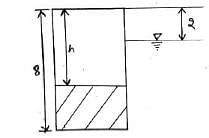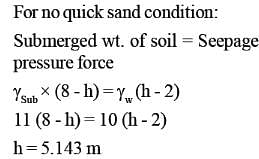Civil Engineering (CE) Exam > Civil Engineering (CE) Questions > In a 8m thick stratum of fine sandhaving subm...
Start Learning for Free
In a 8m thick stratum of fine sand having submerged density of 11kN/m3, excavation is to be made. The water table is at a depth of 2m below the ground level. Calcuate the maximum permissible depth of excavation such that there is no quick sand condition possible? Take density of water as 10 kN/m3. During excavation, dewatering operation is also carried out: _____m.
(Important - Enter only the numerical value in the answer)
Correct answer is '5.143'. Can you explain this answer?
| FREE This question is part of | Download PDF Attempt this Test |
Verified Answer
In a 8m thick stratum of fine sandhaving submerged density of 11kN/m3,...


Most Upvoted Answer
In a 8m thick stratum of fine sandhaving submerged density of 11kN/m3,...
Given data:
Thickness of sand stratum (h) = 8 m
Submerged density of sand (γ) = 11 kN/m3
Density of water (γw) = 10 kN/m3
Depth of water table (d) = 2 m
To determine: Maximum permissible depth of excavation and dewatering operation.
Calculation:
1. The safe bearing capacity of soil is given by:
SBC = (γ - γw) × N
where N is the bearing capacity factor, which depends on the type of soil. For fine sand, N = 15.
SBC = (11 - 10) × 15 = 15 kN/m2
2. The maximum depth of excavation can be determined using the following formula:
D = (SBC × B) / γ
where B is the width of the excavation.
Assuming B = 1 m, we get:
D = (15 × 1) / 11 = 1.36 m
Therefore, the maximum permissible depth of excavation without encountering quicksand is 1.36 m.
3. During excavation, dewatering operation is carried out to lower the water table. The amount of dewatering required can be determined using the following formula:
Dw = h - (D + d)
where Dw is the depth of dewatering required.
Substituting the values, we get:
Dw = 8 - (1.36 + 2) = 4.64 m
Therefore, the depth of dewatering required is 4.64 m.
Overall, the maximum permissible depth of excavation is 1.36 m and a depth of dewatering of 4.64 m is required to carry out the excavation safely.
Thickness of sand stratum (h) = 8 m
Submerged density of sand (γ) = 11 kN/m3
Density of water (γw) = 10 kN/m3
Depth of water table (d) = 2 m
To determine: Maximum permissible depth of excavation and dewatering operation.
Calculation:
1. The safe bearing capacity of soil is given by:
SBC = (γ - γw) × N
where N is the bearing capacity factor, which depends on the type of soil. For fine sand, N = 15.
SBC = (11 - 10) × 15 = 15 kN/m2
2. The maximum depth of excavation can be determined using the following formula:
D = (SBC × B) / γ
where B is the width of the excavation.
Assuming B = 1 m, we get:
D = (15 × 1) / 11 = 1.36 m
Therefore, the maximum permissible depth of excavation without encountering quicksand is 1.36 m.
3. During excavation, dewatering operation is carried out to lower the water table. The amount of dewatering required can be determined using the following formula:
Dw = h - (D + d)
where Dw is the depth of dewatering required.
Substituting the values, we get:
Dw = 8 - (1.36 + 2) = 4.64 m
Therefore, the depth of dewatering required is 4.64 m.
Overall, the maximum permissible depth of excavation is 1.36 m and a depth of dewatering of 4.64 m is required to carry out the excavation safely.
Attention Civil Engineering (CE) Students!
To make sure you are not studying endlessly, EduRev has designed Civil Engineering (CE) study material, with Structured Courses, Videos, & Test Series. Plus get personalized analysis, doubt solving and improvement plans to achieve a great score in Civil Engineering (CE).

|
Explore Courses for Civil Engineering (CE) exam
|

|
Similar Civil Engineering (CE) Doubts
In a 8m thick stratum of fine sandhaving submerged density of 11kN/m3, excavation is to be made. The water table is at a depth of 2mbelow the ground level. Calcuatethe maximum permissible depth ofexcavation such that there is noquick sand condition possible? Takedensity of water as 10 kN/m3.During excavation, dewateringoperation is also carriedout:_____m.(Important - Enter only the numerical value in the answer)Correct answer is '5.143'. Can you explain this answer?
Question Description
In a 8m thick stratum of fine sandhaving submerged density of 11kN/m3, excavation is to be made. The water table is at a depth of 2mbelow the ground level. Calcuatethe maximum permissible depth ofexcavation such that there is noquick sand condition possible? Takedensity of water as 10 kN/m3.During excavation, dewateringoperation is also carriedout:_____m.(Important - Enter only the numerical value in the answer)Correct answer is '5.143'. Can you explain this answer? for Civil Engineering (CE) 2024 is part of Civil Engineering (CE) preparation. The Question and answers have been prepared according to the Civil Engineering (CE) exam syllabus. Information about In a 8m thick stratum of fine sandhaving submerged density of 11kN/m3, excavation is to be made. The water table is at a depth of 2mbelow the ground level. Calcuatethe maximum permissible depth ofexcavation such that there is noquick sand condition possible? Takedensity of water as 10 kN/m3.During excavation, dewateringoperation is also carriedout:_____m.(Important - Enter only the numerical value in the answer)Correct answer is '5.143'. Can you explain this answer? covers all topics & solutions for Civil Engineering (CE) 2024 Exam. Find important definitions, questions, meanings, examples, exercises and tests below for In a 8m thick stratum of fine sandhaving submerged density of 11kN/m3, excavation is to be made. The water table is at a depth of 2mbelow the ground level. Calcuatethe maximum permissible depth ofexcavation such that there is noquick sand condition possible? Takedensity of water as 10 kN/m3.During excavation, dewateringoperation is also carriedout:_____m.(Important - Enter only the numerical value in the answer)Correct answer is '5.143'. Can you explain this answer?.
In a 8m thick stratum of fine sandhaving submerged density of 11kN/m3, excavation is to be made. The water table is at a depth of 2mbelow the ground level. Calcuatethe maximum permissible depth ofexcavation such that there is noquick sand condition possible? Takedensity of water as 10 kN/m3.During excavation, dewateringoperation is also carriedout:_____m.(Important - Enter only the numerical value in the answer)Correct answer is '5.143'. Can you explain this answer? for Civil Engineering (CE) 2024 is part of Civil Engineering (CE) preparation. The Question and answers have been prepared according to the Civil Engineering (CE) exam syllabus. Information about In a 8m thick stratum of fine sandhaving submerged density of 11kN/m3, excavation is to be made. The water table is at a depth of 2mbelow the ground level. Calcuatethe maximum permissible depth ofexcavation such that there is noquick sand condition possible? Takedensity of water as 10 kN/m3.During excavation, dewateringoperation is also carriedout:_____m.(Important - Enter only the numerical value in the answer)Correct answer is '5.143'. Can you explain this answer? covers all topics & solutions for Civil Engineering (CE) 2024 Exam. Find important definitions, questions, meanings, examples, exercises and tests below for In a 8m thick stratum of fine sandhaving submerged density of 11kN/m3, excavation is to be made. The water table is at a depth of 2mbelow the ground level. Calcuatethe maximum permissible depth ofexcavation such that there is noquick sand condition possible? Takedensity of water as 10 kN/m3.During excavation, dewateringoperation is also carriedout:_____m.(Important - Enter only the numerical value in the answer)Correct answer is '5.143'. Can you explain this answer?.
Solutions for In a 8m thick stratum of fine sandhaving submerged density of 11kN/m3, excavation is to be made. The water table is at a depth of 2mbelow the ground level. Calcuatethe maximum permissible depth ofexcavation such that there is noquick sand condition possible? Takedensity of water as 10 kN/m3.During excavation, dewateringoperation is also carriedout:_____m.(Important - Enter only the numerical value in the answer)Correct answer is '5.143'. Can you explain this answer? in English & in Hindi are available as part of our courses for Civil Engineering (CE).
Download more important topics, notes, lectures and mock test series for Civil Engineering (CE) Exam by signing up for free.
Here you can find the meaning of In a 8m thick stratum of fine sandhaving submerged density of 11kN/m3, excavation is to be made. The water table is at a depth of 2mbelow the ground level. Calcuatethe maximum permissible depth ofexcavation such that there is noquick sand condition possible? Takedensity of water as 10 kN/m3.During excavation, dewateringoperation is also carriedout:_____m.(Important - Enter only the numerical value in the answer)Correct answer is '5.143'. Can you explain this answer? defined & explained in the simplest way possible. Besides giving the explanation of
In a 8m thick stratum of fine sandhaving submerged density of 11kN/m3, excavation is to be made. The water table is at a depth of 2mbelow the ground level. Calcuatethe maximum permissible depth ofexcavation such that there is noquick sand condition possible? Takedensity of water as 10 kN/m3.During excavation, dewateringoperation is also carriedout:_____m.(Important - Enter only the numerical value in the answer)Correct answer is '5.143'. Can you explain this answer?, a detailed solution for In a 8m thick stratum of fine sandhaving submerged density of 11kN/m3, excavation is to be made. The water table is at a depth of 2mbelow the ground level. Calcuatethe maximum permissible depth ofexcavation such that there is noquick sand condition possible? Takedensity of water as 10 kN/m3.During excavation, dewateringoperation is also carriedout:_____m.(Important - Enter only the numerical value in the answer)Correct answer is '5.143'. Can you explain this answer? has been provided alongside types of In a 8m thick stratum of fine sandhaving submerged density of 11kN/m3, excavation is to be made. The water table is at a depth of 2mbelow the ground level. Calcuatethe maximum permissible depth ofexcavation such that there is noquick sand condition possible? Takedensity of water as 10 kN/m3.During excavation, dewateringoperation is also carriedout:_____m.(Important - Enter only the numerical value in the answer)Correct answer is '5.143'. Can you explain this answer? theory, EduRev gives you an
ample number of questions to practice In a 8m thick stratum of fine sandhaving submerged density of 11kN/m3, excavation is to be made. The water table is at a depth of 2mbelow the ground level. Calcuatethe maximum permissible depth ofexcavation such that there is noquick sand condition possible? Takedensity of water as 10 kN/m3.During excavation, dewateringoperation is also carriedout:_____m.(Important - Enter only the numerical value in the answer)Correct answer is '5.143'. Can you explain this answer? tests, examples and also practice Civil Engineering (CE) tests.

|
Explore Courses for Civil Engineering (CE) exam
|

|
Suggested Free Tests
Signup for Free!
Signup to see your scores go up within 7 days! Learn & Practice with 1000+ FREE Notes, Videos & Tests.
























